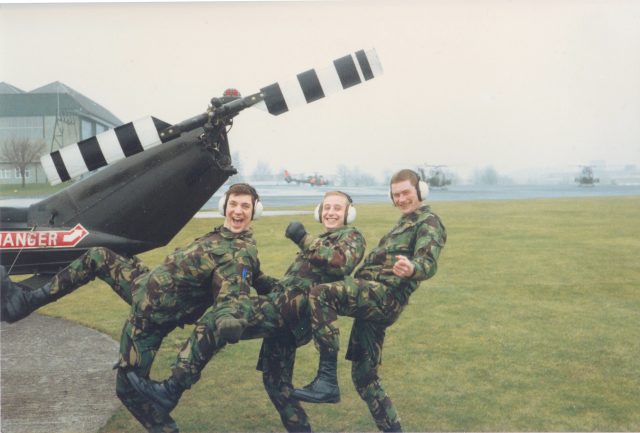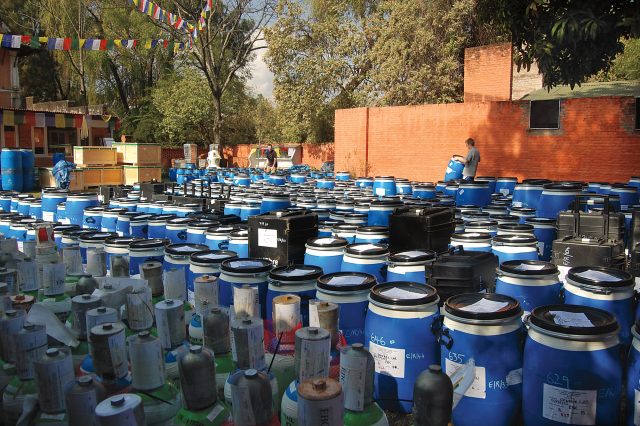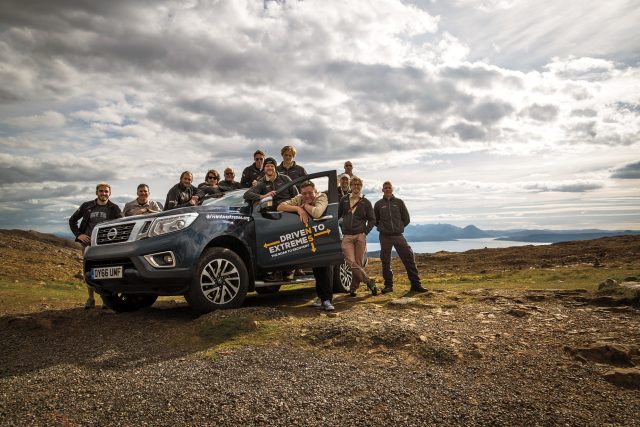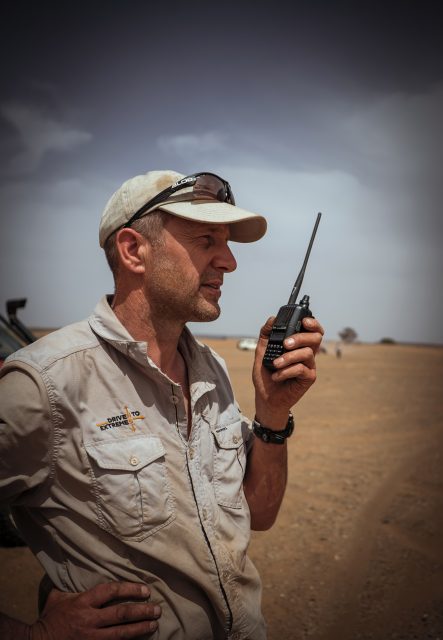Editor’s Note: This article was originally published in Overland Journal‘s Summer 2020 issue.
All men dream, but not all equally. Those that dream by the dusty recesses of the night, awake to find it was all vanity. But the dreamers of the day are dangerous, for they may act their dreams with open eyes and make things happen. –T. E. Lawrence
The above quote is one of Mac Mackenney’s favorites. Driven to accomplish great things, his dreams are constantly evolving, coexisting with the rigors of life. He has a propensity to land on his feet, despite significant struggle, and see those dreams manifest. Mac’s instinct to persevere is always present, a drive that motivates his own objectives but also makes him a logistics planner extraordinaire, sought out by the world’s great explorers and novices alike.
You may know of Mac from his participation in the Discovery Channel’s Driven to Extremes or from his not-for-profit organization of the same name. Or perhaps you are a follower of Sir Ranulph Fiennes; if so, Mac’s name is sure to have come up.
When prompted, Mac Mackenney described himself to me as “a professional adventurer, having planned and led expeditions to the most extreme locations on the planet. From the -60°C freezing wastes of Siberia to the 50°C+ dense heat of the Sahara Desert, through stifling jungles and over precipitous Himalayan mountains, I have set world firsts, broken world records, and operated vehicles in the most challenging environments on earth.”
Mac’s confidence is awe-inspiring, and with large-scale projects such as Everest and a slew of extreme environments under his belt, he truly fits our definition of a Modern Explorer.
From the age of 6, you dreamed of being a Royal Air Force (RAF) pilot. What was your motivation?
My father had always wanted to be a pilot in the RAF, but he didn’t gain the necessary qualifications, so enlisted in the army before joining the Metropolitan Police in London. The police had their own flying club; thus, he obtained his private pilot’s license and occasionally took me with him when he had a lesson—I loved it. There were aircraft books all over the house and trips to airshows and museums.
What were you like before you joined the British military? Did you always find yourself thinking of faraway locales, or maybe drawing up logistics in the schoolyard?
I was a huge daydreamer, always planning adventures—be that climbing mountains, trekking over hills, cycling across the country, or kayaking down rivers. I used to build military-style underground bunkers and rafts made of wood and plastic sheeting. I even drew up plans for a hang glider made of bits and pieces I found lying around.



What was it like growing up in Banstead, England, and how did it shape you?
To be brutally honest, not good. Domestic violence, both physical and psychological, was rife in my family. My parents would mock my daydreaming and plans, referring to me as Walter Mitty, a fictional character invented by James Thurber, who dreamed a lot but didn’t actually achieve anything with his life. From an early age, I was driven to proving them both wrong. My driving force still seems to be to show people I am indeed capable of great things.
I was awarded a flying scholarship at the age of 16, where the RAF pays for you to get your private pilot’s license, but my final selection medical suddenly picked up that I had suspected heart disease. Even though the doctors didn’t find anything serious, the RAF told me that I would never join their ranks. My whole future was in tatters. I managed to pick myself up and finally left home at the age of 18 to join the British Army as a helicopter technician, helped by my army career officer who falsified my medical papers.
How did you find yourself in the RAF then?
After just 18 months in the army, I was told that there was nothing wrong with my heart, and I was fit to join the RAF as a pilot. It took me a few years to get out of the army, but eventually, I made it, becoming an officer and a trainee fighter pilot.
You were soon on the fast track in the British military, only to see your life fall apart while helping a friend through a devastating trauma, which in turn affected you. After suffering a severe panic attack while flying (yet safely landing) a jet, you ended your military career. What led you to create your expedition company, Max Adventure?
Yes, it all went wrong when I lost focus on my flying career while trying to stop a friend who had been date-raped from committing suicide. I was dropped from flying training. Having excelled as an officer, I was offered any ground job that I wanted. But I didn’t feel worthy of continuing to hold the Queen’s Commission, so I resigned.
I was 27 years old with no plan B and no idea what I wanted to do with my life. I took a job driving backpackers around Africa to give me some thinking time. On a daily rate of just £6.00 per day, it wasn’t a career move. I returned from Africa uninspired as every option seemed so boring compared to flying a military jet at 500 mph just 250 feet off the ground. Adventure and travel had started to spark something inside, though, so I sought out greater challenges.
It wasn’t until I entered the Camel Trophy in 1996, and from 10,000 applicants made it down to the final four and the UK team, that I suddenly found something that I could get my teeth into: extreme vehicle adventures.
Your military background probably helped hone your tactical and planning skills, though I suspect they were innate. What experience do you bring to Max Adventure?
The military provided me with a lot of leadership training. But as a mechanic and pilot, detailed planning and tactical elements were not part of my remit, so I guess those elements have come naturally. My main job within Max Adventure is planning and logistics, thinking of every possible scenario on an expedition, and having all of the equipment required in order to complete it successfully. I am able to clearly visualize every step of an expedition before undertaking it, walking through each stage, looking at what’s needed, and building in a backup of contingencies as required.
In 1997, you became Sir Ranulph Fiennes’ right-hand man. Working with the “World’s Greatest Living Explorer” had to feel pretty good after enduring some tumultuous years. Was this when you felt like you had finally “hit the big time”?
I didn’t realize it straight away, but to go from nothing in the expedition world to Ran’s right-hand man in the space of just one year was a pretty rapid promotion. The Land Rover Global Expedition with him was my first major gig. The problem was that Ran took great pride in never actually having paid anyone to be on one of his expeditions during his [then] 35-year career. I treated the experience as an apprenticeship, although I did manage to eke out £500 per month from him on the North Pole Expedition.
What have you learned from working with Ran?
The guy is incredible; his self-focus and dogged determination are probably unmatched by anyone I’ve ever had the pleasure of meeting. Once he’s set his mind on something, there is no question of success—not one thread of doubt. It’s that self-belief that has made him the most successful living explorer. When things get tough for me and aren’t going as planned, I draw upon this inspiration.
There are always unknowns in an overland expedition, but do you find the planning aspect reassuring?
There is a very good saying in the military that can be transferred across to expeditions: “Fail to plan, plan to fail.” And there are the Seven P’s as well: “Prior Preparation and Planning Prevent Piss-Poor Performance.”
Some of my planning spreadsheets stretch to several thousand lines, with everything subdivided into three sections, colorcoded accordingly: Pre-expedition, Expedition, Post-expedition. If you go through line by line, visualizing as best you can what you’ll encounter on the road, there shouldn’t be too many surprises.
What type of vehicle modifications do you address before an expedition?
I try to keep vehicle modifications to the absolute minimum, leaving as much as I can standard. My expeditions are for work, not pleasure—who needs holidays with a job like mine?—so there is no time for sightseeing or relaxing by an open fire, which means no roof tents, no chairs, no fridges, no awnings, no kitchen equipment, and definitely no heavy internal drawer systems. Modifications are only done if they enhance the capability or reliability of the vehicle, with genuine parts being favored over aftermarket.
Weight is the key with a vehicle-based expedition. Just in the same way you would analyze every single item being carried on your back during a mountaineering expedition, you should do exactly the same even though it’s going to be carried by a vehicle. For every 20 kilograms of unnecessary weight, that’s 20 liters of fuel or water that you cannot carry—and they are some of the vital items that will make the expedition a success or failure.


What should be the most important planning factor?
It is the Survival Rule of Three: three minutes, three hours, three days, and three weeks.
PRIORITY 1/SAFETY Don’t stuff it up and have an accident that could result in a catastrophic bleed. Otherwise, it’s game over in as little as three minutes.
PRIORITY 2/SHELTER If your naked body isn’t protected from the elements and you’re in an extreme environment, you could be dead in as little as three hours. Vehicle accidents do happen, and vehicles do catch fire. Where’s your shelter if your roof tent is on the underside of your truck or going up in flames because you can’t remove it quickly enough? Plus, when it’s blowing an absolute gale, where would you rather be? In a ground tent sheltered by your 3-ton truck, or perched 6 feet up in the air, exposed to the full force of Mother Nature?
PRIORITY 3/WATER The average person can survive three days without water.
PRIORITY 4/FOOD The average person can survive three weeks without food.
What suggestions do you have for navigating the paperwork jungle that precedes most significant journeys?
Paperwork isn’t as daunting as it may seem and can be broken down into two definitive areas: vehicles and people. Once you’re on the road, it becomes very logical. Customs officers will want to see all of the car documents, and immigration officers everything connected with you. There will be fees to pay at the border when you enter a country for a range of things such as vehicle insurance, road tax, environmental tax, customs fees, etc. Make sure you have plenty of cash on you, with US dollars being the main global currency, closely followed by euros. I just take a bucket load of money and distribute it amongst the team, hiding it in personal kit bags and throughout the vehicles. Never have all of your cash together in the same place. Take plenty of copies of your vehicle registration document and international certificate for motor vehicles. If an unscrupulous officer holds onto either as a form of soliciting a bribe, you can just drive off knowing you have a whole folder of them.
Your not-for-profit organization, Driven to Extremes, supports veterans suffering from PTSD. What types of missions have you set up?
I came up with the idea for Driven to Extremes when Vauxhall/ Opel, part of General Motors at the time, contracted my company to create and deliver a marketing project that would demonstrate how tough their new Vivaro van was. With only a 1.6-liter turbo-diesel engine, they were concerned that your average builder wouldn’t have much faith in its ability to do a hard day’s work. Their internal marketing team hadn’t got very far with ideas, thinking that the van might be able to drive a track in Scotland or maybe get to Norway. I came in and told them that we could do a lot better by driving from Europe’s most westerly road in southwest Ireland to Asia’s most easterly in far-eastern Siberia—basically Ewan McGregor’s Way Long Round.
Keen to support injured military veterans, I suggested that we take some with us. There was no time to modify the vans [and make them accessible], so we chose three guys suffering from post-traumatic stress disorder (PTSD). The 12,000-mile adventure through 21 countries and across two continents during the 60-day expedition totally turned their lives around. This gave me the inspiration to help more veterans; since I had been through it myself, it gave me the understanding and motivation to help others.
The key to the Driven to Extremes adventures is to make missions fast-paced, in a locale completely different from their home environment. New experiences are key, and variety in everything from accommodation to food is sought out. The challenge has to be sufficient to make teamwork essential, similar to their experiences in the military. And there is no talk of therapy or even mental health; it’s our job to get them back out there in the real world, reversing withdrawal and isolation.
It was a very emotional moment when I finally found what felt like my purpose on this planet, and I committed 100 percent of my time to helping other veterans. When we returned from the Sahara Desert back in 2018, our primary financial sponsor announced that my volunteer efforts were to become a paid fulltime job, with vehicle and legal support, new investors, and the means to make the organization a full-fledged charity. Unfortunately, I shared the good news with one of the Royal Marine veterans we had taken into the desert, and he set up a rival organization and poached the businessman.
The 2020 Sahara Bug Rally rekindled my desire to help, but with a lack of participants and little interest from sponsors, I’ve had to put it on the back burner for now. Hopefully, I’ll be able to rekindle Driven to Extremes, but my current priorities are my family and Max Adventure.

Do you find that planning for potential novices rather than experts is different? Or do you just adjust the curve for everyone?
I must admit, I prefer dealing with projects that will challenge me personally, rather than acting in a tour guide capacity, but both types have their merits. Tough expeditions in extreme environments are my main passion—the harder, the better. Selecting a hand-picked team that you know you can trust and working as a cohesive unit is a great feeling that brings back fond memories from my military days.
Taking those that are new to adventure can bring great rewards when you introduce people to what life on the road can bring. This was especially so when we took a team of military veterans suffering from PTSD to the Sahara Desert. They’d all been to deserts before and part of vehicle convoys, but you don’t really get to interact with the locals in a social way when you’re in the military—having a drink and sharing stories about life from opposing sides of the world is a fantastic way to bring people together.
Where do your ideas come from? For example, what made you decide to try to break the London to Cape Town record (shortest amount of time) in 2010?
I read about the London to Cape Town record in the Guinness Book of World Records back in the early 1980s and knew even then that one day I would have a go at breaking it. As for the others [European Cape to Cape record, a recreation of Stirling Moss’ 1952 visit to 15 countries in less than five days, etc.], I guess it’s just my interest in historical motoring adventures, although I do feel that I was born 50 years too late. I would have loved to have been around in the interwar days when the motor car was capable and reliable enough to travel the world but hadn’t yet been explored by automobiles.
Is this your mantra for life on the road?: drive, navigate, sleep. If not, what else comes into play?
That was certainly the case with our London to Cape Town record when three of us became the sixth team in history to set a new fastest time: 10,000 miles, 21 countries, and three continents in 11 days, 14 hours.
For slower trips, I would say that the other mantra is immerse. Soak in the history, landscape, cuisine, and people of the country that you’re traveling through. This is why we prefer to stay in local hostels and budget hotels, eat in cafés, and employ the services of a local guide. Our camping equipment is therefore extremely minimal to the point that a small survival shelter, a few standby military rations, and self-heating food packs are all that we will take. This not only saves a shed load of money, it also saves weight, allowing better fuel economy, better handling, and room to move in the vehicles.
You assemble huge teams for the majority of your expeditions. Where do you source your people?
Everest was by far the biggest expedition I was responsible for, and the logistics and numbers were indeed huge: 150,000 items of equipment in 1,000 containers to be delivered to seven medical laboratories that we built from Kathmandu to the Summit. The team consisted of 60 intensive care doctors, 60 sherpas, 208 volunteers trekking to Everest Base Camp, 300 porters, 300 yaks, and one Russian helicopter.
The Driven to Extremes Discovery Channel expeditions were therefore quite tame in comparison, with the largest one of the three being the Jungle program where a team of 29 in 11 4WD vehicles tackled a route through the Malaysian rainforest.
We have a pool of very experienced expedition mechanics, medics, safety and survival experts, photographers, and a film crew. All are freelance, and we select them depending on their experience of the environment that we will be traveling through and the type of expedition being planned.


You are known for your expeditions in extreme environments. Where has the most challenging locale been so far?
Siberia, definitely, for the Driven to Extremes Discovery Channel show. NATO forces stop Arctic training at -30°C due to the greatly increased risk of frostbite. At -60°C, we were way beyond that point and operating at temperatures where even basic materials stop acting in the normal way, let alone the human body’s ability to survive. Drive belts, bungees, shock absorbers, and tent materials all act in a totally unusual way that requires you to pick the very best products that are known to cope with such extremes.
Human survival in these conditions is measured in hours, not days, and frostbite can be brought on in a matter of a few minutes. Stuff it up in even the slightest way, and what would be a minor problem anywhere else on the planet becomes lifethreatening in Siberia.
How did you modify the vehicles for Siberia?
We had to pick the right vehicles in the first place, and then modify them to cope with the conditions—nothing more. This meant no winches, snorkels, underbody protection, diff lockers, banks of spotlights, or anything else one would normally associate with a vehicle exped. What it did involve were such things as fitting the right tires, studded Nokians, that wouldn’t blow out at -60°C; Michelin inner tubes that would prevent the tires from deflating at night when the water buildup on the bead turns into ice, expanding and breaking the seal; double glazing on the windscreen and side windows so we could see out; Webasto engine heaters so that the system wouldn’t freeze; Koni insulated shock absorbers so that that they wouldn’t go rock-solid in the cold; neoprene covers over the radiator grill and fuel filler flap; a roll cage for protection; and an engine buzzer that would set off an alarm if the engine stopped. Filling the engine and transmission with the best oil on the market, Shell Helix, took top priority.
What (day)dreams are currently in the queue?
The desire to pursue challenging and extreme driving adventures is what truly makes me come alive on a personal level. I’ve got a load of world firsts and records lined up, and one, in particular, is in the early planning stages, so keep watch. I’d also jump at the chance of exploring North Korea—it would be fascinating.



